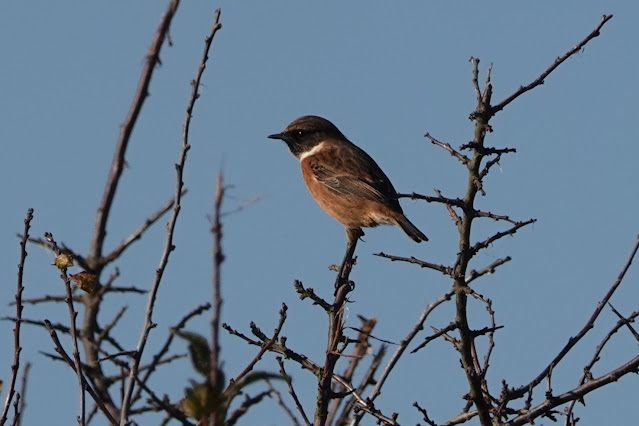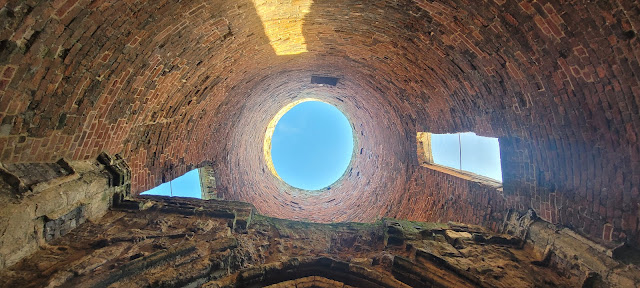A www.blueeyedbirder.com adventure:
I was up before the sun and there was still the sound of Redwings and Blackbirds going overhead in the dark before I headed north to our rendezvous at Winterton. Once there was light it became apparent that there were Blackbirds everywhere and they popped out of hedges and gardens on my journey.
The car park at Winterton was equally populated by these
Scandi visitors and Goldcrests flicked through the Sycamores like a proper
autumn day. A Pallid Swift had spent the
last six days (I think) around the church and had been seen roosting on it but
the weather was so grim yesterday that there were no reports after early
afternoon.
It was cool and grey and after the Whitfields arrived we
ambled down to the church itself and just a few minutes later I picked up the
Pallid Swift leisurely flying just above the rooftops. We scampered around to
the other side and soon found it again as it performed a few circuits on languid
wings. There is something oddly
different about the way a Pallid Swift flies; almost more slowly and
methodically and that coupled with the disassociation of seeing any Swifts for over
two months makes an out of season one look different and also strangely large
in my humble opinion.
.jpg) |
| Pallid Swift - Henry Wyn-Jones from a couple of days ago |
We were treated to several circuits where all the features
were noted before it dipped over a roof and out of sight. We did not see it again and I do not think it
was seen again all day. We were lucky.
And all the while Blackbirds were dropping in in small groups
and singles with others clucking away in the gardens. Pleased with our early success we moved north
to Waxham Barns for a look from the dunes.
 |
| Blackbird |
 |
| Rooks |
Flocks of Fieldfares were seen in the roadside fields but there was too much
farming disturbance for there to be any Geese or Cranes close to us. Skeins of Pinkfeet could be seen descending towards Winterton.
The view from the dunes was murky and there were no Cranes
here either this time but I did find two adult Whooper Swans inland and a large
flock of Pinkfeet amongst hundreds of Gulls loafing on the waterlogged fields.
There were more Blackbirds with the addition of a few
Redwings and quite a few calling Robins and Goldcrests and what I think was a
calling Siberian Chiffchaff. The sea was
flat calm and the tide was in but several scans did produce three female Goldeneye,
four Razorbills, a Guillemot, Teal, six Brent Geese while a single partial sum
plum Great Northern Diver was followed south by a ridiculous group of five
more!
The road through to Hickling was somewhat flooded in parts
but we made it through to a car park illuminated by golden Hazel and Field
Maple leaves still on the trees. The
fact that most of the reserve was under water thankfully did not prevent us
from taking the dry track down towards Stub Mill.
Blackbirds moved along in front of us with a few Redwings
and Song Thrushes amongst them and two Muntjac sat in the field margins. The flood where we saw the Caspian Tern back
in May was so high that the gates were all half submerged and with such levels
there were understandably no duck of any sort to be seen.
The light came and went and Marsh Harriers were constantly
on view as the hunted low over the glimmering silver topped reeds where Reed Buntings and Bearded Tits were seen. The
latter erupting in little groups of up to 15 before dropping back down to contemplate
a future attempt.
 |
| Bearded Tits |
Two Water Pipits came up from, the hidden edges along with
several Meadow Pipits and Pied Wagtails while a set aside patch of sunflowers
was alive with small birds. There were
Chaffinches, Green and Goldfinches and at least 12 Brambling that glinted
white, orange and black in the momentary sunshine. A single Siskin and a gleaming male
Yellowhammer were seen and several tail flicking Reed Buntings.
 |
| Brambling |
The next field along was littered with Starlings and Fieldfares
and four Konik ponies eyed us warily and seemed to want attention but the ears
held back kept hands at a safe distance.
A pair of Stonechats followed them around.
 |
| Stonechat |
 |
| Fieldfares |
 |
| Stonechat |
Rather oddly there was no sound (let alone sight) of any
Cranes whatsoever. The Whitfields had not been to the view point before but we
did not linger long. Marsh Harriers were
again obvious including a fine adult male and a couple of Buzzards and Kestrels
while a Red Kite was circling off towards Winterton where the Pinkfeet still
circled.
 |
| Pinkfeet |
The walk back added a fine Great White Egret in the main channel and a late Migrant Hawker patrolling the sheltered path.
 |
| Great White Egret |
 |
| Stigmella plagicolella |
 |
| Coptotriche marginea |
 |
| Stigmella aurella |
Lunch in the car park and then off again to
St Benet’s Abbey where I hoped there would be some hungry Short-eared Owls
after the last few days of grim weather. As it happened tow were seen before we
even got to the end and like the other week I took us away from the happy
snappers and up to the Abbey ruins where we watched six of these magnificent
creatures hunting around us. The
variation in colour was noticeable with some quite rufous and others
sandy. It was a fantastic
encounter.
 |
| Short-eared Owl |
Flocks of Fieldfares circled around us and came down to mass
bathe in the puddles on the path with a hoard of even more enthusiastic
Starlings and an immature Red Kite circled just above us.
 |
| Red Kite |
With the light holding and the birds showing I opted to move
south to Buckenham Marshes for the Corvid roost. It was cool but still calm as we walked down
the track but the marshes were far drier than I anticipated with no duck visible
until the very end where the usual mass of Wigeon were to be found.
Canadas and Greylags were out on the marsh with so many
Chinese Water Deer dotted across the vista.
I counted 38 in one sweep. A
small flock of Pinkfeet were on the deck with 14 Russian White-fronts which I
was pleased to find and off in the distance skein headed off towards Breydon
Water. Sixteen Linnets were trying to go
to roost in a Bramble clump but there were very few Rooks and Jackdaws around
as the mists started to rise across the marsh and it looked like I was a little
too early in the season for the usual spectacle.
 |
| Chinese Water Deer |
 |
| Greylags in the rising mist |
Suddenly a mass of birds appeared on the southern horizon
but there were not Corvids but Pinkeet and I estimated that 2000 spiralled and
whiffled into the fields with an accompanying wall of goosy sounds. Amongst them was a Ruddy Shelduck but given
my recent duckage exploits I shall just leave that there…
Buzzards were still sitting on fenceposts and a Barn Owl
ghosted along the river wall bank in the gloomy distance while the Chinese Water
Deer seemed to suddenly loom large as the mist came up and highlighted them.
A single Golden Plover, four Snipe and two Ruff were amongst
the Lapwings and a pair of Stonechats were still hunting in the very low light. Starlings started to pour through in swirling
lozenges of blackness and they undulated towards their roost at Strumpshaw.
 |
| Starlings and Pinkfeet |
 |
| Starlings |
Back near the station a few Rooks and Jackdaws were
gathering and swirling around above us.
It was splendid and noisy but not quite what I had hoped for. We waited as they started to head into the
roost trees and then walked back to the cars.
It was now very dark but there was just enough light to see it suddenly
dimmed by a vast cloud of countless thousands of Rooks and Jackdaws pouring in
from the south in one mega flock. The wall
of sound reached us and surrounded us as we stood in awe at this most under-rated
of British wildlife spectacles.


























A really comprehensive account of an excellent 👏 days birding with Howard
ReplyDeleteLove it, missing those Suffolk/ Norfolk birding outings
ReplyDeleteA beautifully-written, evocative account.
ReplyDelete